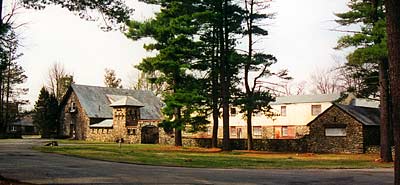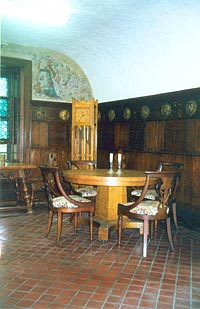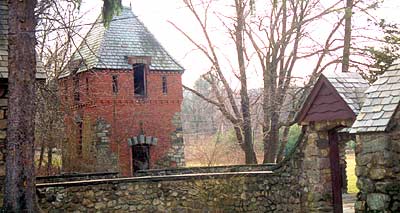 Located in the foothills of the Catskill Mountains in historic Garrison, New York, Saint Basil Academy commands a dramatic view of the Hudson River Valley and West Point Military Academy. The property now occupied by the Academy was once part of a 1686 Crown grant to Philip Philipse, who originally sponsored Captain Kidd as the man to stop the pirates of the day. The property was in turn left to Frederick Phillipse, who upon his death on May 3, 1829, left the property to his sole heir, his daughter Mary Gouveneur. This property was subsequently divided into three parcels. The northern third became known as “Eagles Rest”, belonging to Mary M. Gouveneur, the center third known as “May Cottage” belonging to Mary Philipse Iselin and the southern third known as “Warburton Gouveneur” belonging to Mary Gouveneur. These tracts were in turn sold to General Louis Fitzgerald.
Located in the foothills of the Catskill Mountains in historic Garrison, New York, Saint Basil Academy commands a dramatic view of the Hudson River Valley and West Point Military Academy. The property now occupied by the Academy was once part of a 1686 Crown grant to Philip Philipse, who originally sponsored Captain Kidd as the man to stop the pirates of the day. The property was in turn left to Frederick Phillipse, who upon his death on May 3, 1829, left the property to his sole heir, his daughter Mary Gouveneur. This property was subsequently divided into three parcels. The northern third became known as “Eagles Rest”, belonging to Mary M. Gouveneur, the center third known as “May Cottage” belonging to Mary Philipse Iselin and the southern third known as “Warburton Gouveneur” belonging to Mary Gouveneur. These tracts were in turn sold to General Louis Fitzgerald.
General Fitzgerald was a leading businessman of the community and served from 1875 until 1902 as president of the Mercantile Trust Company. He was born in New York City on May 31, 1838 and was a member of the Seventh Regiment when the Civil War began and marched with it to the defense of Washington. After the war he re-entered the Seventh, holding several officerships, and on March 28, 1882, was appointed Brigadier-General. He retired from the business world in 1902. He died of a heart attack at home on October 6, 1908, and upon his death, the estate passed into the hands of his daughters, Mrs. Ernest R. Adee, Mrs. Harold Fitzgerald and Mrs. Eugene Reynal.
 On January 30, 1919, Colonel Jacob Ruppert purchased the estate. Mr. Ruppert subsequently added to his land holdings the acquisition of a section of land between the old Route 9D which bordered the estate and the new Route 9D which was moved east. This portion was part of the E.R. Dick property and was conveyed by Gilbert Forman on July 9, 1935. A large tract of marshland adjacent to the Astoria Silk Works, the Plumbish Farms and east of Constitution Island was purchased by Jacob Ruppert on January 29, 1926 from James Kirke Paulding and was sold to the Audobon Society in 1976 by the Academy.
On January 30, 1919, Colonel Jacob Ruppert purchased the estate. Mr. Ruppert subsequently added to his land holdings the acquisition of a section of land between the old Route 9D which bordered the estate and the new Route 9D which was moved east. This portion was part of the E.R. Dick property and was conveyed by Gilbert Forman on July 9, 1935. A large tract of marshland adjacent to the Astoria Silk Works, the Plumbish Farms and east of Constitution Island was purchased by Jacob Ruppert on January 29, 1926 from James Kirke Paulding and was sold to the Audobon Society in 1976 by the Academy.
Colonel Jacob Ruppert of the Seventh Regiment of the National Guard was the son of Jacob Ruppert, Sr., founder of the New York City brewery, Jacob Ruppert Co. He was born on August 5, in New York City. A graduate of Columbia Grammar School, he attended Columbia University, but left to join his father’s business. Beginning as a barrel washer, he was General Manager by 1890 and by the turn of the century, he had assumed leadership of the company. Ruppert was President of the firm until his death in 1939. He proved to be an able brew master and more than quadrupled the brewery’s annual output. A shrewd businessman, he increased his holdings by acquiring substantial real estate following the crash of 1929.
Ruppert’s other interest in life was baseball. In 1914, he acquired the New York Yankees for $450,000. By 1931, the team represented a $6,000,000 investment. In 1919, he purchased the site for Yankee Stadium, which opened in 1923.
Ruppert was also senior aide to Governor Roswell P. Flower and served from the 15th NY District to Congress in 1898 for four terms until 1907. He was a trustee of Lenox Hill Hospital and belonged to many clubs and organizations in New York City.
 At “Eagle’s Rest”, he had one of the largest collections of small monkeys, wild birds, and peacocks, in the world. There too, he had a fine collection of furniture, pottery, jade and Chinese porcelains. From his purchase of the estate in 1919, until his death in 1939, he transformed the grounds into a magnificent showplace. Employing over 40 people, over 26 buildings were added and in 1929, he replaced the Fitzgerald’s Victorian clapboard mansion with a cut granite Tudor manor with over 40 rooms. The rooms of the first floor he adorned with fireplaces, wood paneling and brass chandeliers all imported from Western Europe. The southern portion of the estate contained his farm and zoo. On the grounds, he created a piece of the English countryside, with stonewalls, slate roofs, decorative wells, gazebos, landscaped paths and aviaries. The estate was the site of numerous parties. Members of the New York Yankees and his brewery friends often stayed as overnight guests.
At “Eagle’s Rest”, he had one of the largest collections of small monkeys, wild birds, and peacocks, in the world. There too, he had a fine collection of furniture, pottery, jade and Chinese porcelains. From his purchase of the estate in 1919, until his death in 1939, he transformed the grounds into a magnificent showplace. Employing over 40 people, over 26 buildings were added and in 1929, he replaced the Fitzgerald’s Victorian clapboard mansion with a cut granite Tudor manor with over 40 rooms. The rooms of the first floor he adorned with fireplaces, wood paneling and brass chandeliers all imported from Western Europe. The southern portion of the estate contained his farm and zoo. On the grounds, he created a piece of the English countryside, with stonewalls, slate roofs, decorative wells, gazebos, landscaped paths and aviaries. The estate was the site of numerous parties. Members of the New York Yankees and his brewery friends often stayed as overnight guests.
